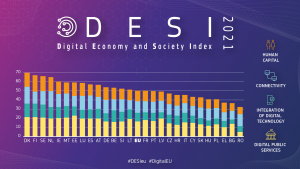The phenomenon of digitalisation is becoming an integral part of our daily life.
So, considering digitalization in European SMEs: where do we stand today?
Although new digital solutions are increasingly popular in the market, it would be wrong to assume that all companies have adapted to this digital transformation.
All EU Member States have made progress in the area of digitalisation; the overall picture across Member States is varied.
The gap between EU’s frontrunners and the lowest ranked ones remains large and there is still room for improvement.
All Member States will need to make concerted efforts to meet the 2030 targets as set out in Europe’s Digital Decade
So, what is the current state of digitalisation in European countries?
Let’s find out by analysing the results of DESI, the Digital Economy and Society Index together!
DESI and October’s pan-European perspective
The European Commission has been monitoring Member States’ digital progress through the Digital Economy and Society Index (DESI) reports since 2014.
Each year, the Digital Economy and Society Index (DESI) provides information on the state of digitisation of EU member states. In an increasingly competitive and challenging market environment, the European institutions consider it essential to monitor the development of this phenomenon.

October is a Fintech company active in business lending to small and medium-sized companies. Leveraging both technology and data, October offers innovative, simple and easily accessible credit solutions to European companies by securing funds from both private lenders and institutional investors. The combination of these two financing channels allows companies to access capital from international markets.
Operating in five European countries, we studied the progress in terms of digitalisation of the economies and societies, as well as SMEs, in Italy, France, Spain, the Netherlands and Germany.
For each country in which October operates, we will try to find and summarise the most interesting aspects of each of these four areas.
- Digital skills (or human capital)
The human capital dimension of the DESI covers ‘internet user skills’ and ‘advanced skills and development’.
- Connectivity
This is the area of broadband connectivity
The connectivity dimension looks at both the demand and the supply side of fixed and mobile broadband.
- Integration of digital technology
This dimension measures the digitalisation of businesses and e-commerce.
- Use of digital in public services
This indicator considers out of all internet users, the percentage of individuals who used the Internet in the last 12 months for interacting with public authorities.
What ranking positions are the different countries?
Keep reading to find out more!
Italy room for improvement

In the DESI 2021, Italy ranks 20th out of 27 EU Member States.
Only 41.5% of the Italian population aged between 16 and 74 have basic digital skills.
In addition to this, Italy has a very low percentage of graduates in the ICT sector, accounting for only 1.3%
Although Italy is not one of the top performers in terms of digital performance, there is room for improvement.
In 2021, the Italian government promoted digitalisation through new initiatives and strategic plans. One of these is The National Recovery and Resilience Plan.
The Italian Recovery and Resilience Plan is the largest in the EU, accounting for a total of around EUR 191.5 billion.
The 25.1% of it (i.e. approximately EUR 48 billion) is devoted to the digital transition. This plan would enable Italy to digitise the public administration and the judicial system. It would also contribute to the strengthening of the healthcare system through digital technologies and the modernisation of businesses through the uptake of advanced technologies.
Gigabit connectivity would also be implemented throughout the country!
Moving on to SMEs, which are becoming increasingly receptive to online opportunities, as seen from by the strong growth of direct lending in recent years.
According to DESI, Italian SMEs perform very well in the employment of e-invoices, although the use of big data and technologies based on Artificial Intelligence remain low. The uptake of e-commerce and the use of ICT for environmental sustainability are also below the EU average.
Most Italian SMEs have at least a basic level of digital intensity (69%, well above the EU average of 60%).
So there are promising signs for the future.
Technology in The Netherlands

The Netherlands ranks 4th out of 27 EU Member States in the 2021 edition of the DESI. Therefore, it remains one of the top performers across Europe, with a widespread uptake of digital technologies among companies and use of online services. As well as high levels of basic and advanced digital skills.
Despite being an already highly digitised country, the Netherlands has taken new measures to further optimise its digital transformation.
Here are the most interesting ones.
The Dutch Digitalisation strategy, first adopted in 2018 and updated in 2019, 2020 and 2021, is based on three solid principles.
- Be in the vanguard and grasp opportunities;
- Everyone joins in and we work together;
- Trust in the digital future.
In 2020, despite the pandemic, 155 Code Week activities were organised in the Netherlands.
EU Code Week is a grassroots initiative which aims to bring coding and digital literacy to everyone in a fun and engaging way.
In 2020, the adoption of the National Growth Fund was worth EUR 20 billion, which was reserved for infrastructure, innovation, and R&D, including sizeable portions allocated to AI, health data infrastructure, digital education technology and quantum technology.
And what about SMEs?
As stated at the beginning of this section, 75% of Dutch small and medium-sized enterprises (SMEs) have at least basic levels of digital intensity.
Furthermore, the Netherlands is a signatory to the declaration on the European Cloud Alliance. In signing this, it agreed to drive the uptake of more secure, interoperable and energy-efficient data centres and cloud services, in particular, for SMEs, start-ups and the public sector.
France, the homeland of European Fintech

France ranks 15th of the 27 Member States in the 2021 edition of the Digital Economy and Society Index (DESI).
The country is in line with the EU average in terms of digital skills, both basic and advanced, and still has the chance to move closer to the EU front runners.
To achieve this, France is investing significant resources in connectivity, the education system and the use of digital technologies.
But what does the French plan include?
The French Recovery and Resilience Plan (RRP) will contribute to supporting the country’s digital transition with an overall contribution of EUR 8.4 billion.
The digitalisation of healthcare, in particular, will be supported with an investment of EUR 2 billion. The aim is to improve the sharing of medical records to set up the digital health platform and to ensure interoperability among software of actors in the public and private sectors.
And again, what about SMEs?
The French Digital Skills and Jobs Coalition runs a number of activities to promote digital skills.
At the moment, a project is being implemented in cooperation with the Ministry of Labour, focusing on the use of AI for companies, in particular SMEs.
Spain’s great achievements

Spain ranks 9th among the 27 EU Member States in the European Commission’s 2021 edition of the DESI.
This is one of the countries that has made the most significant progress.
It is a strong performer in Digital public services thanks to the digital-by-default strategy throughout its central public administration.
Spain also performs very well in Connectivity and has equally been improving on Human capital.
However, companies have not yet taken sufficient advantage of new technologies such as Artificial Intelligence (AI), big data and cloud. And they could help further develop productivity and e-commerce.
So let’s discover the strategic plans adopted by Spain to improve its level of digitisation.
- In 2020, Spain adopted a new and ambitious digital agenda, Digital Spain 2025. The purpose it to promote Spain’s digital transformation through a set of reforms up to 2025. As well as significant public and private investment;
- Spain’s RRP, devotes a total amount of EUR 19.6 billion to digital. With a particular focus on promoting the digitalisation of businesses, including SMEs.
The Spanish economy is indeed driven by SMEs. However, Spanish businesses are still not taking full advantage of the online economy and SMEs are lagging behind on digitalisation.
Spain launched the SME Digitalisation Plan 2021-2025 to boost disruptive innovations and entrepreneurship in digital.
Germany’s pro-SMEs

Germany ranks 11th out of 27 EU Member States in the DESI 2021. Germany performs relatively well in broadband connectivity and is a leader in 5G readiness.
Furthermore, the country is second in the EU in overall fixed broadband take-up.
Also Germany has adopted strategic plans to improve digitisation at a national level.
Let’s find out more!
Germany’s Recovery and Resilience Plan is going to further support the economic recovery. It has a total budget of up to EUR 26.5 billion and includes significant investments in digitalisation.
What about SMEs?
As part of the national SME strategy (Mittelstandsstrategie), the National Regulatory Authority set up the new unit ‘Digitisation & networking in SMEs’ to actively accompany the digitisation process in SMEs.
With so many data and plans, what are the prospects?
The five countries covered in our overview show a good outlook on digital evolution. Companies and entrepreneurs have realised that technology and data are not only the future. But are also essential for the functioning of our economy and society today.